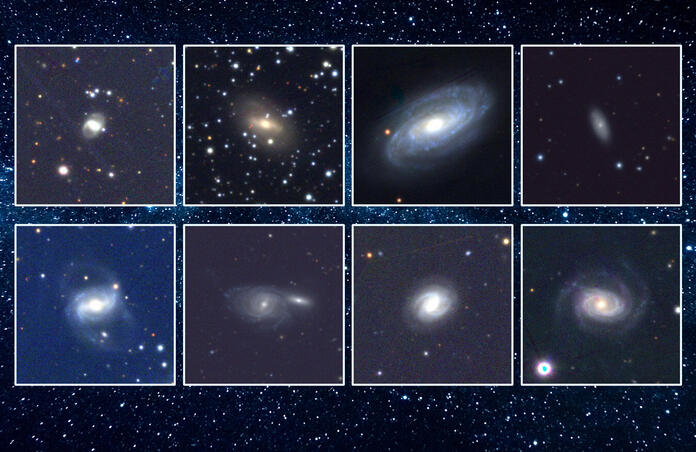MIT team discovers 18 new tidal disruption events

The discovery of 18 new tidal disruption events (TDEs) have been reported in a new study submitted in The Astrophysical Journal. The team of MIT scientists have more than doubled the catalog of such events, with just over a dozen previously reported.
TDEs are extreme events whereby a close star is drawn into a black hole and subsequently ripped apart. As the black hole devours the star, it releases a vast amount of energy across the entire electromagnetic spectrum. Previous TDEs have been detected through the search for characteristic bursts in the optical and x-ray bands, resulting in around a dozen detections in the nearby universe.
However, the team spotted the hidden events by looking in the infrared. Infrared radiation can be generated, especially in dusty galaxies where the central black hole is covered by galactic debris. The dust would normally absorb and obscure the optical and x-ray light, hiding any potential TDE signal. However, the dust heats up which produces detectable infrared radiation. Therefore, such emission can be used as a potential sign of a TDE. Using this, the team found an abundance of TDEs in galaxies where they were previously hidden.
"The majority of these sources don't show up in optical bands," says lead author Megan Masterson, a graduate student in MIT's Kavli Institute for Astrophysics and Space Research. "If you want to understand TDEs as a whole and use them to probe supermassive black hole demographics, you need to look in the infrared band."
The team searched through archival observations taken by NEOWISE- a renewed version of NASA’s Wide-field Infrared Survey Explorer, launched in 2009. NEOWISE scans the entire night sky for infrared “transients” or brief bursts. An algorithm developed by co-author Kishalay De was used, whereby patterns in infrared emission that are likely signs of a transient burst were flagged. Then, the flagged transients were cross-referenced with a catalog of all known nearby galaxies within 600 million light years (200 megaparsecs), ultimately finding that the infrared transients could be traced to around 1000 galaxies.
Following this, the group zoomed in on the signal of each galaxies infrared burst to determine whether the signal is due to a source other than a TDE e.g. AGN or supernova. Once other possibilities were ruled out, the remaining signals were analysed in search of a pattern characteristic of a TDE: a sharp spike followed by a gradual dip. This represents a process where the black hole, in the midst of ripping a star apart, suddenly heats up to around 1000K before gradually cooling down.
Such an analysis uncovered 18 “clean” TDE signals, occurring in a range of systems spanning a wide area of the sky including dusty galaxies. "If you looked up in the sky and saw a bunch of galaxies, the TDEs would occur representatively in all of them," Masterson says. "It's not that they're only occurring in one type of galaxy, as people thought based only on optical and X-ray searches."
The discovery aids several major questions which have arisen in the study of TDEs. For example, until now astronomers had seen TDEs occurring in mainly one type of galaxy – a “post-starburst” system that had previously been a star-forming factory but has settled since. This galaxy type is rare, which puzzled astronomers as to why TDEs are being found almost exclusively in these uncommon systems. However, these systems also have relatively low levels of dust, thus the TDE emission signal in the optical and x-ray is easy to detect. From the new study, we now know that observing in the infrared provides astronomers with the ability to see TDEs in a wider range of galaxies.
These findings also resolve the “missing energy” problem. Theoretically, physicists have predicted that TDEs should radiate more energy than what has been observed. However, the MIT team have stated that dust could be the explanation. If a TDE occurs in a dusty galaxy, the dust can absorb extreme UV radiation as well as optical and x-ray emission in amounts comparable to the “missing” energy. Additionally, the plethora of new detections helps astronomers to estimate the rate at which TDEs occur in a given galaxy. With the new TDEs, it is estimated that a galaxy experiences a disruption once every 50,000 years, closer to theoretical predictions than previous calculations.
With more observations in the infrared, the team can resolve the rate of TDEs along with better understanding the properties of the black holes which fuel them. "People were coming up with very exotic solutions to these puzzles, and now we've come to the point where we can resolve all of them," Kara says. "This gives us confidence that we don't need all this exotic physics to explain what we're seeing. And we have a better handle on the mechanics behind how a star gets ripped apart and gobbled up by a black hole. We're understanding these systems better."
--
Cover image: Megan Masterson, Erin Kara, et al.
Journal source: Megan Masterson et al, A New Population of Mid-infrared-selected Tidal Disruption Events: Implications for Tidal Disruption Event Rates and Host Galaxy Properties, The Astrophysical Journal (2024). DOI: 10.3847/1538-4357/ad18bb
